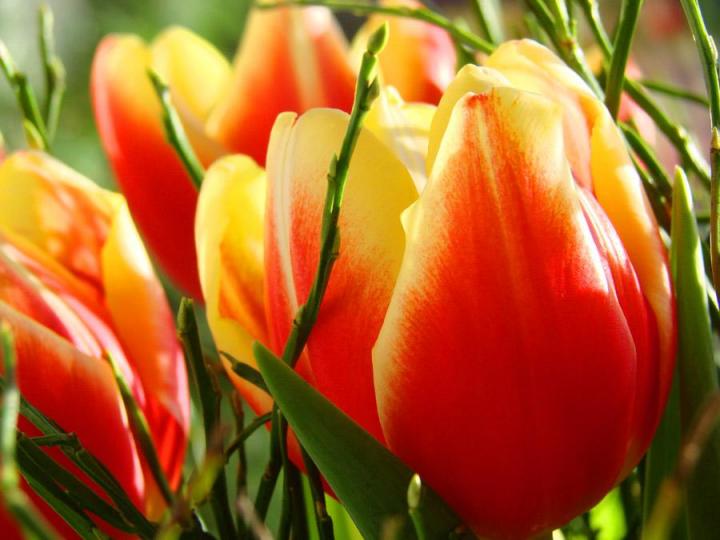
A winter's Sun on Dutch tulips.
See how to grow tulips!
Karen Oudeman
Where to buy tulip bulbs: Burpee Gardening
Long live the tulip! We can buy tulip bulbs in virtually all colors, including a purple so deep that it looks black. And by planting a selection of varieties of this perennial, we can enjoy their beauty from early spring through early summer.
Tulips do best in areas with dry summers and cold winters. The brightly colored, upright flowers may be single or double, and vary in shape from simple cups, bowls, and goblets to more complex forms. They are excellent in beds and borders; many types are good for forcing into bloom indoors, and most are excellent for cut flowers.
Although tulips are a perennial, many gardeners treat them as annuals, to be planted anew each year. The North American climate and soil can’t replicate the ancient Anatolian and southern Russian conditions of their birth. Gardeners in our western mountain regions come closest to this climate.
Planting
- Nature never intended for bulbs to loll about above ground, so don’t delay planting the bulbs after purchase.
- Plant tulip bulbs in the fall, 6 to 8 weeks before a hard frost is expected and when soils are below 60 degrees F. (See our frost dates.) This timing ranges from early autumn (Zone 4) to late autumn (warmer zones). To find the best dates, see our fall bulb planting chart.
- In southern climates with mild winters, you need to buy pre-chilled bulbs or chill them yourself in the refrigerator for about 12 weeks before planting.
- Tulips prefer a site with full or afternoon sun. In Zones 7 and 8, choose a shady site or one with morning sun only.
- All tulips dislike excessive moisture. Ideally, the soil is well-drained, neutral to slightly acidic, fertile, and dry or sandy.
- Rainy summers, irrigation systems, and wet soil are death to tulips. Never deliberately water a bulb bed. Wet soil leads to fungus and disease and can rot bulbs. Add shredded pine bark, sand, or anything to foster swift drainage.
- You’ll want to space bulbs 4 to 6 inches apart, so choose an appropriate plot size.
- To deter mice and moles—if they have been a problem—put holly or any other thorny leaves in the planting holes. Some gardeners use kitty litter or crushed gravel.
- If ravenous rodents are a real problem, you may need to take stronger measures, such as planting bulbs in a cage of wire.
- Plant bulbs deep—at least 8 inches, measuring from the base of the bulb. And that means digging even deeper, to loosen the soil and allow for drainage, or creating raised beds. Remember, the bigger the bulb, the deeper the hole it needs.
- Set the bulb in the hole with the pointy end up. Cover with soil and press soil firmly.
- Water bulbs right after planting. Although they can’t bear wet feet, bulbs need water to trigger growth.
- If you’re planning to raise perennial tulips, feed them when you plant them in the fall. Bulbs are their own complete storage system and contain all of the nutrients they need for one year. Use organic material, compost, or a balanced time-release bulb food.
- Don’t lose hope if you’re planting your tulips late in the season—just use these tips.
Care
- Water tulips during dry spells in the fall; otherwise, do not water.
- Compost annually.
- Deadhead tulips after flowering.
- Allow the foliage to yellow for about 6 weeks after flowering before removing it.
- The bulbs of Species tulips may be left in the ground for several years; others may be lifted annually, once the leaves have died down, and ripened in a warm, dry place.
- Replant the largest bulbs; smaller bulbs may be grown in containers in a bulb frame, in mix of equal parts loam, leaf mold, and sharp sand. When in growth, water moderately, applying a balanced liquid fertilizer weekly for 3 or 4 weeks after flowering; keep dry in summer, and repot annually.
Pests/Diseases
- Gray mold
- Slugs
- Snails
- Aphids
- Nematodes
- Bulb rot
- Squirrels, mice, and voles are especially fond of tulip bulbs.
Recommended Varieties
Tulip flowers may be single, double, ruffled, fringed, or lily-shaped, depending on the variety.
Wild, or Species, tulips are small in size, ranging in height from 3 to 8 inches. They are tougher than hybrids. They also bloom in the South and looks best when planted as a carpet of color. One of our favorites is ‘Lilac Wonder’.
Triumph hybrids are the classic single, cup-shape tulip that make up the largest grouping of tulip types. Top varieties:
- ‘Cracker tulip’ is a midspring bloomer with purple, pink, and lilac petals.
- ‘Ile de France’ is a midseason bloomer, with its intensely red blooms on stems to 20 inches tall.
- ‘Calgary’ is a midspring bloomer with snowy-white petals and blue-green foliage.
There are so many beautiful varieties of tulips. Explore catalogs and experiment in your garden!
Wit & Wisdom
- Did you know: If you dig up a tulip bulb in midsummer, it’s not the same bulb you planted last fall. It’s her daughter. Even while the tulip is blossoming, the bulb is dividing for the next generation.
- To get the longest vase life, cut tulip stems diagonally, then wrap the upper two-thirds of the flowers in a funnel of newspaper and stand them in cool water for an hour or two. Then, recut the stems and the tulips will last at least a week.
- In 17th-century Holland, the new tulip was such the rage and fashion that a handful of bulbs was worth about $44,000.
- Red tulips symbolize a declaration of love. Explore more flower symbolism here.






